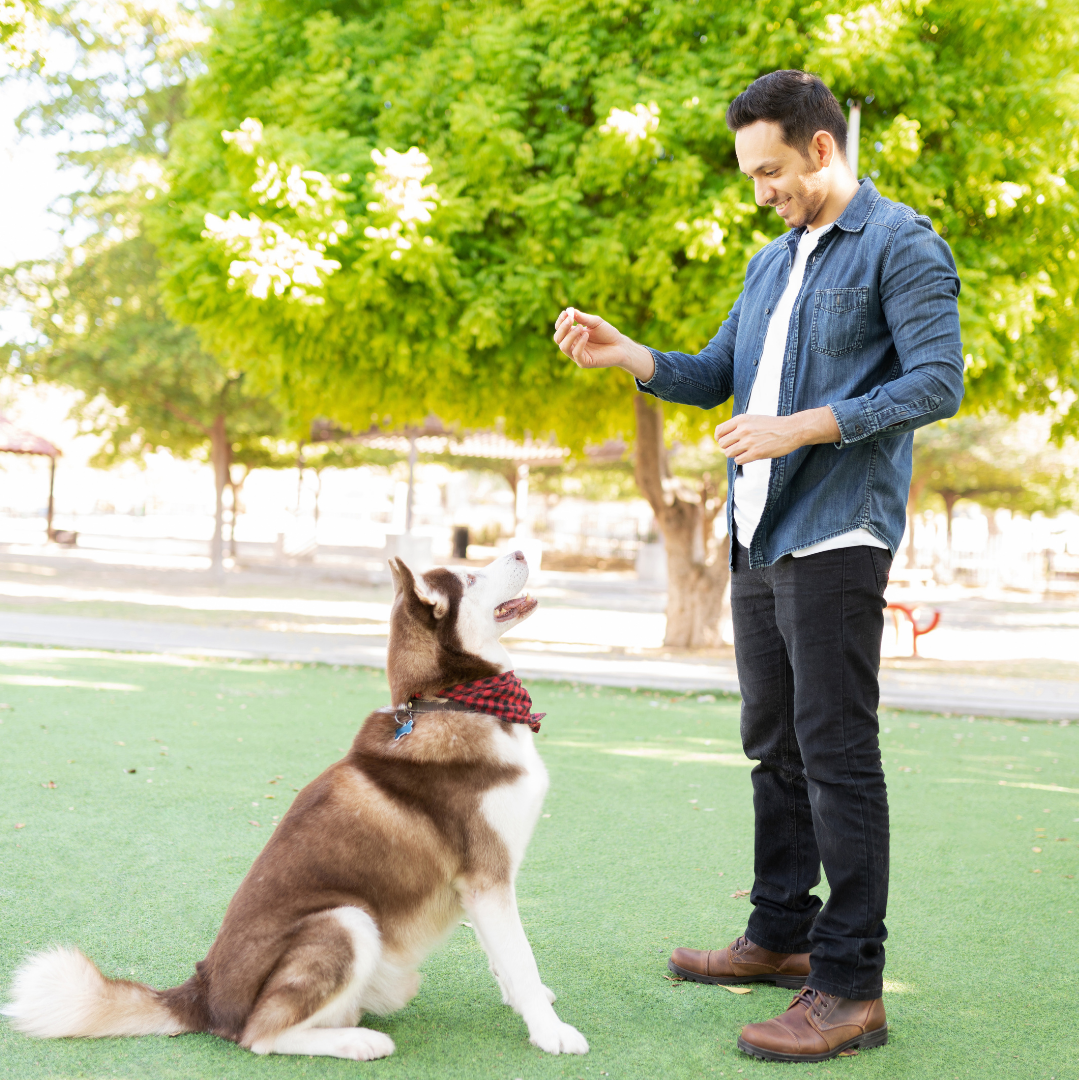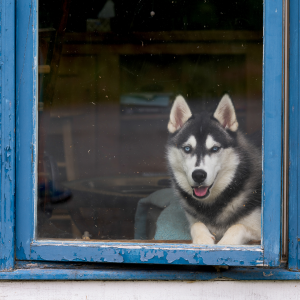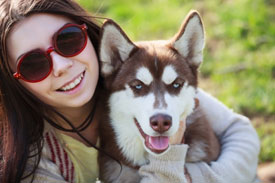Have you fallen under the spell of large limpid eyes and a saucy grin? Enchanted by the regal appearance –and wolf like qualities? And, were you flummoxed by the “turn around” when you brought the little one home?
Did you find the constant demand for attention alarming? Did the barking and nipping shock you? Were you astounded by the immense curiosity and thirst for mischief?
Well, welcome to the world of the Siberian Husky — underneath the friendly façade, lies a will of steel.
Wondering how to temper /mould the steel?
Well, it requires patience, persistence, and determination.
One can, turn the vagabond into a well-behaved gentleman –you just have to follow the “golden rules.”
Burn up the energy
As several studies have shown, all canines including Siberian Huskies have a personality that is in actuality a reflection of their energy levels. They are known to have short bursts of energy followed by rest periods.
In order for you to keep and maintain a balance in the Siberian’s life you will have to ensure that 50% of the dog’s interaction is exercise. And mind you exercise does not mean pottering around the house. The Siberian Husky needs at least 30 minutes of exercise everyday to burn off its excess energies and this does not include “play” time.
You the pet owner/parent needs to ensure that 25% of the 50% is training exercises. This does not mean just obedience school or short spurts of training done 2-3 times a day but obedience that is a part of daily life.
Practice “nothing in life is for free” and you will reap rewards. The Siberian Husky must learn to obey and earn his praise, petting, treats and so on. Never ever give in to the limpid/sorry looks. I am sure you are aware what happens when you “spoil the child.”
The balance 25% of the interaction should be affection. I am sure, that as long as your Siberian is being good you ignore him and go about your duties. And, only “pay attention” when he is bad – jumping, barking, running with toilet paper in his mouth. Well, you are giving him negative attention – which means to draw your attention he must behave badly. Do try and pay attention when he is good – praise him, pet him, hug him – tell him what a good boy he is.
What is the best training method for your Siberian?
What is the most popular training method in use today? The answer would be “positive reinforcement.” The concept “Nothing in life is free” is a successful way to live happily with your Siberian Husky.
It just needs a strong mind—my Siberian Husky is going beyond cute, it is going to be a CGC—Canine Good Citizen. And, in order to ensure this you need to earn the Siberian’s trust and respect. The dog must accept you as the leader.
To start the program, you need to make a list of activities the Siberian Husky loves. And, teach him basic puppy commands like: sit, down, stay, shake, speak, roll over, and so on.
Now, much before any “loved” activity like play, petting, rubbing, or a walk, the Siberian Husky must execute one of the commands well – no shirking no avoiding.
The rule you must remember is simple “No work. No Play.”
Here is how:
You:
Put his leash in place to go for a walk.
Feed him.
Play with him when you return from work.
Rub his belly or scratch his head while watching TV.
In turn he must:
Sit patiently until you attach his leash.
Must lie down and stay until you put his food bowl down.
Must sit and shake hands each time you throw a ball/toy for him to fetch.
Must lie down and roll over before being petted.
Once you have given a command he must obey, otherwise you should not give him what he wants –walk away and ignore him. And begin once again after a few minutes. Show persistence and patience and you will find that he will toe the line.
The benefits are:
Most dogs will acknowledge that you are the leader—the alpha. They will follow your lead. This helps establish control even over a dominant dog.
Even with affectionate/manipulative dogs this works, as you indicate you are no push over for a few licks/nudges/or limpid eyes.
Obeying commands helps build confidence in dogs and makes them feel very secure.
This works because; dogs descend from pack animals that have a social structure and hierarchy. The hierarchy serves to maintain order, reduce conflict, and promote harmony as well as cooperation within a group. In order that the home environment remains a haven and a safe happy place for pets – it is important for you to assume the ‘alpha’ position. By you and your children practicing “Nothing in Life is for Free,” your dog learns that he, in hierarchy, ranks below you and the children.
12 Golden rules for every Siberian owner
Discipline and good behavior are not just for your Siberian they apply to you, the pet parent too. Buying a dog is not all “cochie coo” business — it signals the beginning of a lifetime of commitment and responsibility.
Love your dog unquestioningly. Treat him like a friend. Never hurt, punish, beat or abandon him. Seek professional help if you are ever pushed against the wall – there are feasible solutions to everything.
Ensure good nutrition.
Take an informed decision about spaying/neutering.
Give him good veterinary care. Half yearly check ups, vaccinations, dental check ups, and more.
Ensure that all his papers are in order – get him an ID and license.
Training is a key to a long and fulfilled life.
Groom him everyday or as many times as necessary. Grooming is one way of bonding with the dog.
Socialize your dog from day one – this will help him be comfortable around other people and animals as well as in public places.
Devote at least 30 minutes everyday to play with your dog.
Ensure that you are a lawful dog owner– obey all leash, vaccination, and noise pollution laws.
Always clean up after your dog – it prevents infections.
Exercise your dog for at least 30 minutes each day.
These golden rules will help you grant the boon of a good life to your Siberian Husky and believe me a dog that leads a well balanced life hardly ever develops any behavioral problems.
What should you know about your Siberian Husky before you start training?
In order to train your dog perfectly, you need to know him well – his needs, behavior, as well as moods. If you comprehend clearly the “world” of the Siberian you will be able to train him perfectly –draw on his strengths and work on his weaknesses.
As you know, dogs including the Siberian Husky have descended from animals that lived in packs and their everyday instincts are based on that social structure. Learn about inborn behavioral trends and use the knowledge to train your Siberian.
Dominance and Hierarchy—Most Siberian Huskies respond well to leadership or will try and be leader. In packs it is the leader who decides on the actions of the family/group. Who eats first, where to go, what to do, and so on. And within the group are challenges for the position of “alpha” from other males. So, in the “home” context the pack for the Siberian Husky is you and your family. In order for life to be smooth you must assume the role of alpha.
So, if your Siberian Husky is leading you a merry dance you know who the boss is? And, with the Siberian you need to establish you position and earn their respect if you want to successfully train them. Being alpha will enable you, to control your Siberian Husky and instill good behavior. If you oscillate in your behavior –sometimes boss at other times slave then the Siberian Husky will be one confused dog.
Aggression: This is a behavior that is deeply ingrained in the Siberian Husky. In packs animals establish territories and defend them with zeal. This instinct is what makes your Siberian snappy and nippy. Anyone, person, animal, or child that is seen as a threat is nipped. Keep a watchful eye and nip these tendencies in the bud.
Food Protection: Many animals, even Siberian’s will guard food. And when they feel any threat they will bark/bite. This is not to be encouraged. Food training is a must.
Running away: Many animals run away from danger. You may find that your Siberian also takes flight. Make him feel safe, protect him from the “demons,” help him overcome his fears. If you train your Siberian Husky to be obedient you will not have to worry about “running away” he will happily, maintain a “sit” or “stay.”
Socialization: Since dogs live in packs in the wild they are never alone /lonely. Similarly, your Siberian cannot be left alone for long hours—he will become bored, unhappy, depressed, and chew things or trail toilet paper all over the house or bring the sheets down or tumble the wash — anything that will draw your attention.
Vocalization: Animals in the wild communicate using different sounds. So barking is the way your Siberian Husky communicates with you. Beware Siberian’s are incessant barkers and could become a nuisance. You must teach “stop” or “no bark.”
So, if you understand “why” then you can do the needful.
Formulating a learning plan
Today there are tests that can be done that evaluate accurately the willingness of a dog to learn.
The test indicates:
The Siberian Husky’s ability to accept domination.
The dog’s response to unfamiliar noise.
The curiosity present.
The Siberian’s fear level
The ability to fetch/retrieve.
Stamina and motivation level.
The evaluation will help you in the learning plan that you formulate for your dog.
Key secrets to remember in training
While training the Siberian Husky please remember:
Do not punish the dog. Punishment is not a training aid. It does little to foster willingness to learn and achieve. Limit yourself to a firm “NO” and to using your hands to block the dog’s negative actions. Refrain from hitting or physically abusing the dog.
Display extreme levels of patience and persistence – never give up; if you do, you are relinquishing your status as the dominant one. The dog is bound by nature and genetics to test how far he can push you or get away with disobeying you. You must display a stern and stoic attitude and do not pat, praise, or reward the dog if he does not pay attention or refuses to do as you have asked. Only yield once your commands are followed. If you “heel” instead of your “dog” then you will soon know who is the boss.
Be consistent in your training schedule. Always schedule a class at the same time of the day and for a fixed period –your dog will soon recognize that it is the time to learn and will willingly come forward. During training, both coordination and the trainer’s movements have a direct correlation to the dog’s comprehension. So, if commanded “come”, the dog must be gently guided towards the trainer by a helper or by using a leash so that the pet realizes that “come” means that he must go towards the master.
Be repetitive with each learning block until the trick/lesson is mastered. Some lessons will be learnt quickly while others will take a while. The pattern is different for different dogs and varies from case to case.
Use rewards and praise as often as required. Praise should immediately be forthcoming when a dog responds to any command. The pet will associate responding to commands with praise/rewards (treats) and will try and respond quicker to reap his rewards. Once a command/trick has been mastered then the treats can be withdrawn. You will find that obeying a command becomes second nature to the Siberian Husky.
Keep the lessons simple. To begin with, the lessons should be fairly easy and such that the dog can complete it within two-three actions. As his level of learning increases the lessons could be more complex. Just as our children go, at first to play school, then to kindergarten, and then to the first grade so also in the case of our pets.
Respect the intelligence of your pet and allow him to think –use his mind. Give time to your pet to figure out what is asked of him. Do not try and help him complete the set task. If you do so, the pet will allow you to do the work for him. If you display patience, the dog will realize what you need him to do and he will obey you directions.
Treat the dog as you would a colleague/ student. You must, talk to your Siberian explain what it is all about. Speaking to the dog while training will ensure that the dog keeps his attention focused on you. He will soon master the different tones used by you to give commands.
Do not plan long sessions –their attention span is short. Therefore, short lessons are learnt better. It is recommended to have short 10-minute sessions repeated 2-3 times a day.
How to become a successful trainer?
While reams have been written and expounded on training secrets and the psychology of the Siberian Husky one often tends to forget that the “mason” is the one who lays the bricks and makes the building strong. In this case it is the “attitude” of the trainer. Have you wondered why some trainers have “a touch” while others just get by? Well it is because they are in complete synchrony with the Siberian Husky.
# So, to be a good and successful trainer, you will need to develop your skills in a holistic/rounded manner—knowledge, patience, affinity for your dog, enthusiasm, a learning zeal, and more should all be coalesced in a productive way.
# To be a trainer who produces a “top” dog you must instinctively know what motivates your Siberian Husky. What is it that can be tapped to make him a “team” player?
# Your Siberian Husky may take to some learning like a duck to water and yet turn its back on certain things—here your skills come to the fore, you will need to make the “distasteful” attractive and enjoyable. You will need to gauge your Siberian Husky’s mood and change the training approach appropriately.
# Another important and often forgotten aspect is that you must work at a pace that the Siberian Husky is comfortable with – for each lesson you must revise until the little Siberian has learnt thoroughly. Vary the order of the commands to that the Siberian Husky has to “pay attention” and think – he must not mechanically execute commands. Each step must be taken with steadfastness.
# It is important, for you to remain calm and to motivate the dog at the right moment. Play your voice, whistles, and hand signals in a way that the dog will recognize what you are about to say. Siberian Huskies are so attuned to their trainer/owner that they will, after a while pre-empt your commands. The little dog will read your mind clearly.
# Develop your extra sensory perceptions to recognize the Siberian Husky’s moods—if the dog is willing to learn, then you must take the day’s learning all the way. If he seems distracted — just play with him and execute a few simple lessons. If the Siberian Husky is listless declare an impromptu holiday – spend the lesson time cuddling your pet, giving him a relaxing massage or take him for a drive.
# Never try and train if, you yourself are feeling low, irritable, or off color—it does not achieve anything. Take a day or few days off — the world will not come to an end or stop.
Never train your Siberian Husky when:
You are unwell.
You are angry, negative, or upset.
You are low on patience or out of energy.
When the mind is distracted or there is too much traffic in the training area.
When you are not confident on how to execute a certain lesson – postpone until you have time to clarify with your trainer or school.
Like all first class trainers you too should adopt the four Cs –Calmness, Consistency, Communication, and Concentration. To raise a prince you need to be a seer.
We Must Learn Too
To be successful teachers we too must learn –often it is our ignorance that leads to disasters. We must, constantly update our knowledge and learn better and more innovative ways to communicate with our canine friends.
Some tried and tested methods are:
Leash handling: The ideal way is to begin with your arms hanging loosely down with the palms facing inwards. The loop of the leash should be placed over the right thumb with the loose end crossing the palm. The next step is to fold the leash like an accordion to a manageable length. The loose end should emerge from under the little finger. Then the leash must pass through the loop made by the thumb and index finger of the left hand and across the palm. Hold the leash loosely in your left hand; from here to your dog’s collar the leash should have enough length to form a “j” In popular parlance this is referred to as the “control start” position. This permits better control of the dog. The right hand should always be stationary while the left hand makes all the necessary corrections.
Footwork: At all times footwork is your biggest aid in training. While executing turns if you do not place your feet properly you could trip the dog and cause a disturbance in the synchronization. Moving quickly also causes forging or lagging. Footwork should be consistent and the foot closest to your dog should lead. Pace is crucial don’t race or pick up-tempo sometimes and saunter at other times. It is beneficial to place your feet in a “T” position whilst turning
Timing and use of body language: It is essential to move together. If you say heel and start walking even before the word leaves your lips then you are making it difficult for your dog to follow your commands. You must pause for a second after giving the command –this gives enough time for the dog to respond accurately. In order to establish a certain pattern, it is advisable to incorporate delays of 1-5 seconds before responding. Since dogs are extremely receptive animals they can respond very quickly to body language. It is for them an inherited trait. The pet will recognize your smile as a welcoming gesture. Similarly, towering or leaning over is considered to be threatening. Just raising your hand is enough to convey –a threat/displeasure. So it is essential for you to master body language. Similarly, hand signals help the dog perform many tasks.
Why do you need Canine Good Citizens certification?
If you want your Siberian Husky to participate in dog activities like therapy groups then you need to obtain a Canine Good Citizens certification for your pet.
The “Canine Good Citizens” certification is based on 10 steps that demonstrate the owner’s control over the dog, and the dog’s behavior in given situations. They are:
Accepting a friendly stranger.
Sitting politely while being petted.
Spic and span appearance –good grooming.
Walking on a loose leash.
Walking through a crowd.
Obedience to sit and stay commands.
Interaction with handler.
Amicability to other animals.
Tolerance to/of distractions.
Supervised isolation.
In order for you to ensure that the little Siberian Husky passes the test. You must train the Siberian to perfection.
You need to:
Steel your emotions and not given into to limpid pleading eyes or a wistful looks. If the pup is disobedient and ignores your command or the word “no,” you must instill discipline by: ignoring the pup; walking away; taking away privileges.
Whilst training use a “tone” that is firm – your stance, facial expression, and voice should say, “I will brook no nonsense.” Never get excited and shout or flay your hands – it will only serve to excite the puppy. Use a voice that is soft, certain, and firm.
Instill respect in him — he must acknowledge you as “alpha” or leader. Once this is achieved then the pup will always obey you.
Use only positive methods – never physically harm the puppy. Stern methods are a thing of the past.
Socialize the Siberian Husky with care and patience. Take him to the park, club, beach, ball game, on holidays and so on. The more people and animals he meets the better socialized he will be.
In case you come across any problems like—aggression, fear, or timidity take steps to correct the Siberian Husky. If required, do meet a behaviorist he/she will guide you in the right way.
You must make time to bond with the Siberian Husky — pet, cuddle, talk to him, and show him you care.
Teach your puppy to give to space—he must learn to stay alone at times. Otherwise you will become the Siberian’s prisoner.
Communication is important you must understand each other’s needs.
Enrich his life and he will enrich yours.
It is quite simple — follow the basic rules and you will be surprised how well your Siberian shapes.
The perfectly well behaved dog
Everyone loves a perfect dog: one who is loving, patient, well mannered, and educated. And….
Permits you his owner to touch him even when he is ill/injured and allows to you administer medication/dressing.
Is well mannered, busy, socialized, and spends most of his time at home with his family.
Listens and obeys commands and is attentive, he wants to stay close to you.
Will walk by your side and heel beautifully, will not run, pull, drag or strangle. • Will drop it/leave it as soon as you say so.
Will sit as soon as you point or order him to.
Understands what he can and what he cannot do.
Acknowledge you as pack leader.
Here is a toast to the “Master of the Universe,” — the well-behaved Siberian Husky.





